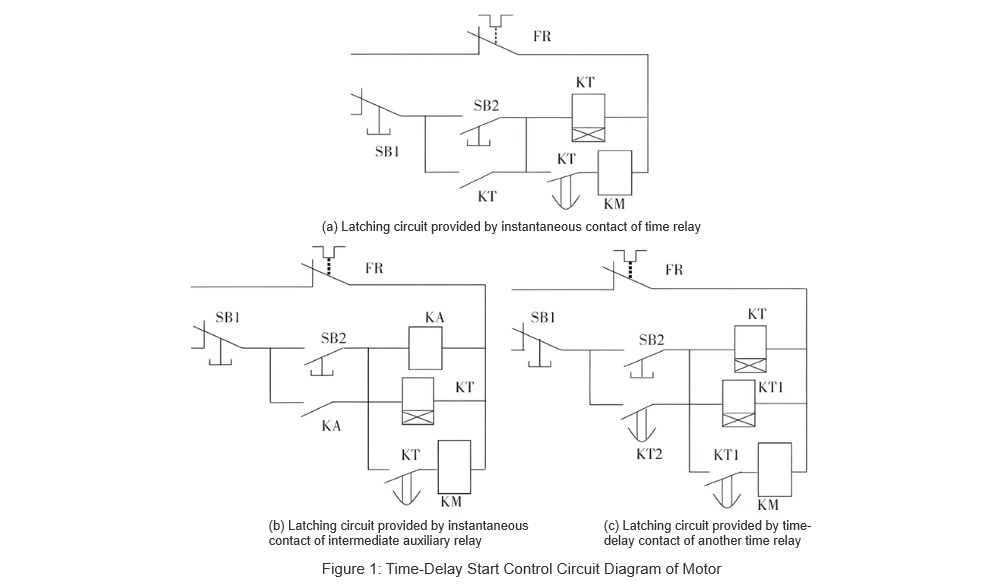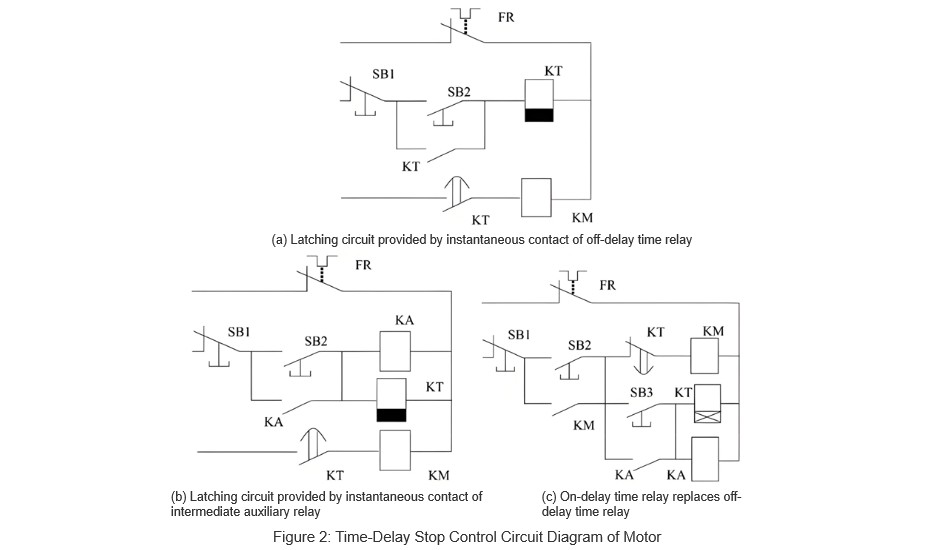Ang mga time relay mao ang kasagaran nga gamiton sa industriya nga mga kontrol device. Batas sa ilang timing characteristics, sila mahimong ikategoryahan ngadto sa tulo ka klase: on-delay, off-delay, ug combined on/off-delay relays. Sa katugbang niini, ang mga on-delay time relays mao ang pinaka gamit ug adunay sa market. Gaynon, daghan sa mga on-delay relays adunay limitado nga numero sa contacts ug naghatag lamang sa timed contacts walay instantaneous ones, nga naghimo og inconvenience sa mga electrical control circuit designs nga nagkinahanglan og immediate response contacts.
Bisan pa, sa panahon sa pagdisenyo sa equipment circuit, ang dili available nga espesipikong klase sa relay kasagaran nag-uhom sa mga engineers. Busa, duha ka pangunehang isyu ang kinahanglan nga i-address: (1) Paano mapalapad ang application range sa on-delay time relays nga wala'y instantaneous contacts? (2) Mahimo ba ang on-delay time relays nga gamiton isip substitute sa off-delay relays kung wala gyud sila? Aron matubag ang mga tanong niini, ang paper naa mosugyot og systematic study batas sa JSZ3A-B time relay, gamiton ang delayed-start circuits, delayed-stop circuits, ug star-delta starting circuits isip ektsemplo, naghatag og practical references.
1. Working Principle and Types of Time Relays
Ang operasyon sa time relays gikan sa electromagnetic attraction ug release principles. Ang typical relay gisakop sa electromagnet nga may coil ug movable iron core. Kon ang coil energized, ang gihatag nga magnetic field mag-attract sa movable core, pinaagi niini ang circuit ma-close o ma-open. Ang kinahanglang time delay iset pinaagi sa adjustment sa knob o dial sa relay.
2. Parameters of the JSZ3A-B On-Delay Time Relay
Ang JSZ3A-B time relay adunay compact size, light weight, high structural integrity, wide timing range, high timing accuracy, excellent reliability, ug long service life, nga gitawag nga suitable para sa automatic control systems sa machine tools ug integrated equipment. Ito naghatag og multiple rated control voltage options, selectable from AC 12–380 V o DC 12–220 V. Ang timing range includes 1 s, 10 s, 60 s, ug 6 min, switchable via a selector switch sa front panel. Ang relay naghatag og four sets of timed contacts: two normally open timed-closing contacts ug two normally closed timed-opening contacts. Timing accuracy ≤0.5%, ug ang operating temperature range -5°C to +40°C.
Isip on-delay relay, ang JSZ3A-B adunay otso ka terminals. Ang terminals 2 ug 7 connect sa power supply; ang contacts 1–3 ug 8–6 mao ang timed-closing (NO); ang contacts 1–4 ug 8–5 mao ang timed-opening (NC). Ang users makapili sa appropriate contacts para sa circuit design batas sa ilang needs.
3. Applications of the JSZ3A-B On-Delay Time Relay
Ang time relays adunay wide use sa electrical control circuits nga nagkinahanglan og timed motor operations, including delayed start, delayed stop, ug star-delta starting circuits.
3.1 Motor Delayed-Start Control Circuit Design
Ang motor delayed-start control circuit based sa self-locking (latching) circuit. Ito nag-achieve sa time-delayed motor control pinaagi sa connection sa normally open timed contact sa JSZ3A-B time relay in series sa contactor coil. Ang control circuit shown sa Figure 1(a). As shown sa Figure 1(a), ang control circuit includes ang time relay coil, a timed normally open auxiliary contact, ug an instantaneous (immediate) contact. Pero, ang JSZ3A-B on-delay time relay naghatag lang sa timed contacts ug wala'y instantaneous ones. Sa pagdisenyo sa practical circuits, kon ang similar issue mopangita, ang sumusunod duha ka methods makapangita para resolve it.
3.1.1 Method One
Ang unang method mao ang simplest ug most commonly used: using the normally open auxiliary contact sa intermediate relay o contactor aron maghatag sa motor self-locking path. Kini method easy for beginners to understand ug implement. Ang specific motor control circuit diagram shown sa Figure 1(b). Bisan pa, replacing the intermediate auxiliary relay KA sa control circuit uban ang another contactor KM usab makapangita sa control requirements.
3.1.2 Method Two
Ang ikaduha nga method using the normally open timed contact sa another JSZ3A-B on-delay time relay aron maghatag sa self-locking path. Kini achieved simply pinaagi sa setting sa iyang time delay sa zero. Ang corresponding motor control circuit diagram shown sa Figure 1(c).
Aside sa delayed-start control circuits, ang delayed-stop motor control circuits usab representative.

3.2 Motor Delayed-Stop Control Circuit Design
Ang off-delay time relays operate such that their contacts act immediately upon coil energization without any delay, pero reset with a delay when the coil de-energized. Kini characteristic aligns perfectly sa requirements sa delayed-stop motor control. Busa, using off-delay time relays makes it relatively straightforward sa pagdisenyo sa motor delayed-stop control circuit. Ang control circuit diagram shown sa Figure 2(a).
3.2.1 Off-Delay Time Relay Without Instantaneous Contacts
Ang circuit design illustrated sa Figure 2(a) fairly easy to understand. Pero, sa practical applications, kon ang off-delay time relay wala'y instantaneous contacts, ang intermediate auxiliary relays o the normally open auxiliary contacts sa contactors makapangita isip substitute sa instantaneous contacts sa time relay. Ang modified motor control circuit diagram shown sa Figure 2(b).
Operation process: Close the main circuit knife switch QS, press the start button SB2, ug ang intermediate relay KA ug time relay KT energized. Ang normally open auxiliary contact sa KA closes, achieving self-locking. Ang timed-off contact sa KT closes immediately, energizing the contactor KM, allowing the motor to run normally. When pressing the stop button SB1, both KA ug KT de-energized. After the preset delay time elapses, ang timed-off contact sa KT opens, de-energizing the KM coil, causing the motor to stop.
3.2.2 Using On-Delay Time Relays Instead of Off-Delay Time Relays
Kon ang off-delay time relay wala, mahimo ba ang on-delay time relay nga gamiton isip substitute? Taking the JSZ3A-B on-delay time relay as an example, ang circuit control diagram can be modified accordingly. Ang revised motor control circuit diagram shown sa Figure 2(c).
Operation process: Close the main circuit knife switch QS, press the start button SB2, ug ang contactor KM energized. Ang normally open auxiliary contact sa KM closes, achieving self-locking, allowing the motor to run normally. Pressing the start button SB3 energizes the intermediate relay KA ug time relay KT. Ang normally open auxiliary contact sa KA closes, achieving self-locking. After the preset delay time elapses, ang timed-on break contact sa KT opens, de-energizing the KM coil, stopping the motor. Simultaneously, ang self-locking contact sa KM1 opens, de-energizing both the time relay KT ug intermediate relay KA.
Kini approach allows for a flexible solution kung wala ang specific types sa time relays, ensuring continuous operation ug reliability sa motor control circuits.

3.3 Motor Star-Delta Starting Control Circuit Design
Sa industrial ug agricultural production, aron mapangita sa impact sa motor startup sa power voltage ug other equipment, para sa motors nga mas dako nga capacity nga normal nga operate sa three-phase stator windings connected in delta configuration, ang star-delta reduced voltage starting makapangita aron limiton ang starting current. Sa panahon sa startup, ang motor first connected in a star configuration. When the motor speed reaches a certain value, ang time relay activates, switching the connection to delta for normal operation.
3.3.1 Using Off-Delay Time Relays for Control Circuits
Ang control circuit can utilize the off-delay timed-off contacts sa off-delay time relay. Ang control circuit design shown sa Figure 3(a).
Operation process: Close the main circuit knife switch QS, press the start button SB2, ug ang intermediate relay KA, time relay KT, ug contactor KM3 simultaneously energized. Ang normally open auxiliary contact sa KA closes, achieving self-locking. Ang timed-off contact sa KT immediately closes, energizing the coil sa contactor KM1 ug de-energizing KM2, starting the motor in star configuration.
Since KM1 energized, ang iyang normally closed contact opens, de-energizing the KT coil. After the preset delay time elapses, ang timed-off contact sa KT opens, de-energizing the KM1 coil. Ang normally closed contact sa KM1 then closes, energizing the coils sa contactor KM2 ug time relay KT. Ang normally open contact sa KM2 closes, achieving self-locking, while its normally closed contact opens, de-energizing KM3, disconnecting the star connection, ug switching to delta configuration. Simultaneously, ang timed-off contact sa KT re-closes, re-energizing the KM1 coil, allowing the motor to run normally in delta configuration. Pressing the stop button SB1 de-energizes the KM1 coil, disconnecting the main circuit, ug stopping the motor.
3.3.2 Using On-Delay Time Relays for Control Circuits
Kon ang type sa time relay limited, ang timed-off contacts sa on-delay time relay can replace the timed-off contacts sa off-delay time relay. Ang modified motor control circuit diagram using JSZ3A-B shown sa Figure 3(b).
Operation process: Close the main circuit knife switch QS, press the start button SB2, ug ang intermediate relay KA, time relay KT, contactor KM1, ug KM3 simultaneously energized, while KM2 de-energized. Ang normally open auxiliary contact sa KA closes, achieving self-locking, starting the motor in star configuration. After the preset delay time elapses, ang timed-off contact sa KT opens, de-energizing the KM1 coil.
Ang normally closed contact sa KM1 then closes, energizing the KM2 coil. Ang normally open contact sa KM2 closes, achieving self-locking, while its normally closed contact opens, de-energizing KM3, disconnecting the star connection, ug switching to delta configuration. Simultaneously, ang normally closed contact sa KM3 closes, re-energizing the KM1 coil, allowing the motor to run normally in delta configuration. Pressing the stop button SB1 de-energizes the KM1 coil, disconnects the main circuit, ug stops the motor.
Throughout the entire switching process sa both control circuits mentioned above, ang main contactor KM1 remains de-energized, providing effective safety protection for the motor.

4. Conclusion
Kini paper, using the JSZ3A-B as an example, presents the application of on-delay time relays without instantaneous contacts sa motor delayed-start control circuits, delayed-stop control circuits, ug star-delta starting circuits. Ito provides practical solutions sa electrical circuit design kung wala ang specific types sa time relays.
























